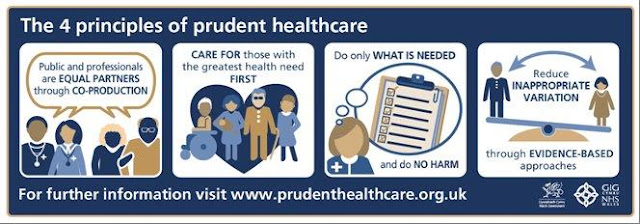The Prudent Healthcare Blogs - Principle One
The Prudent Healthcare Blogs
Principle One
Public and professionals are equal partners through coproduction
Coproduction, like any word which is adopted into policy or
management processes, can often feel like a rather hackneyed term and is not universally
popular. However, the concept which it describes is extremely important to the
delivery of modern healthcare services and for improving the experience and
outcomes of the people using those services. Here is a definition of
coproduction from the Social Care Institute for Excellence:
‘A way of working
whereby citizens and decision makers, or people who use services, family carers
and service providers work together to create a decision or service which works
for them all.’
For this principle we need to be applied in the context of
Prudent Healthcare we must consider to what extent people are (and feel)
involved in caring for their health at both a micro and a macro level.
At a micro level, coproduction is referring to shared
decision making. This is the process by which healthcare professionals help
people to make choices. Doing this really well requires time, taken often over
multiple consultations, ideally utilising the differing skill sets of the
multidisciplinary team. This should include not only discussions about drugs,
radiotherapy or surgical interventions, but also when/if to have a scan or take
holidays or any other activity important to that person. All trade-offs in that
decision making process should be explored and understood.
It is all too easy to fall into the trap of jumping to
conclusions about what our patients’ priorities are, perhaps focusing only on
the clinical outcomes as seen through the lens of the clinician.
There are a number of necessary steps in the shared decision
making process:
·
A realistic shared view of the situation, taking
into account cues from the individual on the amount of information shared and
the pace at which this is done, the degree of self-efficacy and health
literacy.
·
An appreciation of psychosocial and other
contextual factors
·
An exploration of fears, beliefs, expectations,
wants, needs and goals
·
Shared goal setting
·
Imparting understanding of treatment options and
choices available
·
Acknowledgement of uncertainty
As clinicians we must continuously check our self-awareness
as, often with the best of intentions, we tend to default to action when this
may not be what the person with us would choose or be in their best interests.
This can be difficult as we want the best outcomes for those we care for and we
do not like to fail. We are often afraid and we have so little time to meet the
holistic needs of the person sitting before us. Therefore good coproduction is
most likely to occur when the multidisciplinary team work together seamlessly
across the whole system to support the individual all through their treatment
and beyond.
As Atul Gawande says in his book ‘Being Mortal’, ‘Life is
choices. They are relentless’.
At a macro level, the public must be given the opportunity
to make a direct contribution to the design of local services. It is fair to
say that we have a long way to go before we achieve this to a high standard in
all areas. In promoting public health
and sustaining our healthcare system we should seek to reach a balance between
the rights and responsibilities of individuals. This brings into question the
experience of public services and fostering a sense of community but there is
an onus on service providers to promote equality, diversity, accessibility and
reciprocity when embarking on the co-productive process. When these pillars are
not in place, the process is tokenistic, of limited value and tends quite
rightly to disengage those involved.
When done well, coproduction begins with active listening
and the subsequent interaction between the involved groups produces a rich seam
of information which can inform a much improved patient experience and better,
more innovative and flexible ways of meeting the healthcare needs of the
population in question.
If we adopt the approach detailed above in its entirety, we
will surely have a better chance of improving patient experience, healthcare
outcomes and going some way to create a sustainable health service for the
future. Surely then, coproduction is something we must take very seriously
indeed.
Dr Sally Lewis
September 2016


Comments
Post a Comment